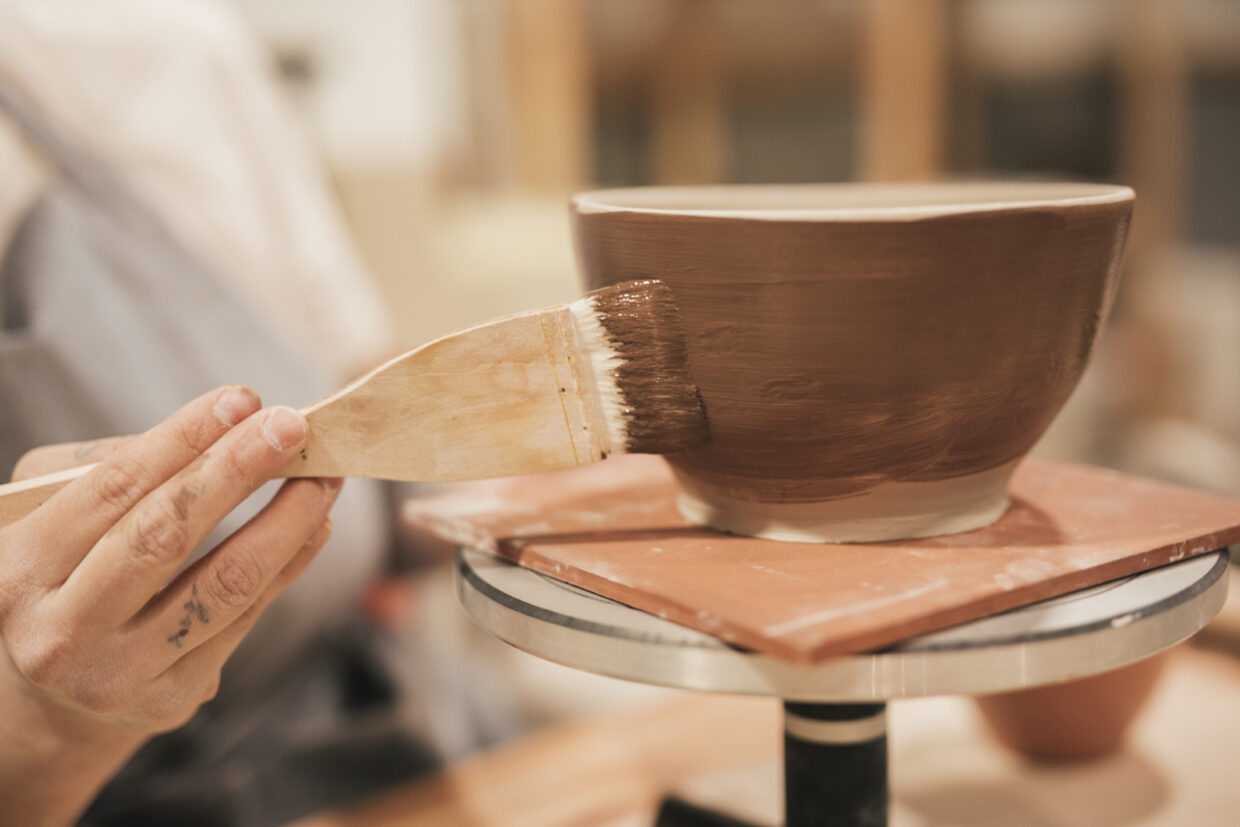
Learn about glazes! The secret to bringing out the beauty of ceramics
What is glaze?
Definition and role of glaze
Glaze is a glassy film that covers the surface of ceramics, also known as “glaze”. It turns glassy when fired and provides many benefits to ceramics. Firstly, glaze reduces water absorption, preventing ceramics from absorbing water. This makes the pottery more durable and long-lasting. Glaze also increases stain resistance, making it ideal for use as tableware and decorative items. Furthermore, glaze also plays an important role in decoration, adding unique colors and patterns to ceramics, enhancing their beauty and artistry.
History of Glazes
Glazes have a very long history, having been used since before the Common Era. In ancient Egypt and Mesopotamia, glazes were already being used to decorate pottery. In China in particular, glazing technology developed from around 2000 BC, and celadon glazes came into widespread use during the Han dynasty. Glazing technology was also introduced to Japan during the Nara period, and glazes with unique textures were developed during the Heian period.
The development of glazes has varied by culture and region, with each region developing its own unique glazing techniques to suit the raw materials and climate of the region. For example, Chinese celadon glaze and Japanese kiseto glaze boast beauty and techniques unique to their region. A wide variety of glazes are still in use today, and their range of applications continues to expand.
Types of Glaze
Glaze classification
Glazes are classified into various categories based on their ingredients and intended use. They can be broadly divided into three categories: alkaline glazes, neutral glazes, and acidic glazes. Alkaline glazes are characterized by their high transparency and high luster, and are used especially for vitreous glazes. Neutral glazes have excellent fire resistance and can be produced in a wide variety of colors. On the other hand, acidic glazes are used to create unique textures and colors, and are often used especially for matcha bowls and tea utensils. In addition to these classifications, there are many other types of glazes depending on their ingredients and blends.
Representative types of glaze
There are many different types of glazes depending on their ingredients, each with its own unique characteristics and color. For example, transparent glazes, as their name suggests, are highly transparent and are widely used as a basic glaze. Ash glazes are mainly made from wood ash and are characterized by a natural greenish color. Green glazes often contain copper and have a beautiful green color. Kiseto glazes have a yellow to orange color and are particularly used in traditional Japanese crafts. Celadon glazes contain iron, so they can change from blue to green depending on the firing temperature and conditions, allowing for a wide variety of expressions. These representative glazes play a role in greatly enhancing the beauty and practicality of ceramics.
How to make and use glazes
Basic recipe
Glaze is a glassy film that covers the surface of ceramics, also known as “Uwagusuri”. The basic method of making glaze is to first finely grind the raw materials and mix them with water to make a slurry. This allows the glaze to properly adhere to the ceramic surface and prepare it to form a uniform glassy film during firing.
The main components of glazes are silica, alumina, alkali oxides, etc., and the properties of the glaze are determined by the specific ratios of these components. The appropriate mixture of components varies depending on the type of glaze desired, such as transparent glaze, green glaze, celadon glaze, etc.
Differences in application methods
There are several ways to apply glaze to ceramics, the main methods being dipping, pouring, spraying and painting.
In the dipping method, the pottery is dipped into the glaze and then pulled out, which is characterized by the fact that it is easy to achieve a uniform thickness. In the pouring method, the glaze is poured directly from the container onto the pottery, and is used when you want to create different color shades in different areas. In the spraying method, the glaze is sprayed onto the pottery, and since fine particles can be evenly distributed over the surface of the pottery, it is suitable for expressing unique textures and uneven coloring. Finally, in the painting method, the glaze is applied with a brush or paint brush, and it is easy to create fine patterns and apply multiple coats, allowing you to enjoy the texture of something that is made by hand.
It is important to experiment with test pieces to see the difference in finish and color with each application method. This will help you find the glaze method that will bring out the best in the beauty of your ceramics.
The effects and beauty of glazes
Gloss and color
Glaze is a glassy film that covers the surface of ceramics, and is also called “Uwagusuri”. It turns glassy when fired, giving ceramics a beautiful luster and rich color. This luster not only reduces the water absorption of ceramics, but also improves their durability and stain resistance.
A wide variety of colors are produced depending on the ingredients of the glaze and the firing conditions. There are glazes with their own unique characteristics and colors, such as transparent glaze, ash glaze, green glaze, yellow Seto glaze, celadon glaze, etc. These colors are used according to the design and purpose of the ceramics, enhancing the appeal of the work.
Pattern and texture
Glazes can also add patterns and textures, adding variety to ceramic design. For example, there are several ways to apply glazes, including dipping, pouring, spraying, and painting, and each method produces different finishes and colors. This allows for a variety of expressions to be created using the same glaze.
In addition, unique patterns and textures can be created on the surface depending on how the glaze is applied and how it is fired. The flow and shrinkage of the glaze that occurs during the firing process can sometimes result in accidental patterns. It is important to try out various methods on test pieces in pursuit of the optimal finish.
As you can see, glazes are an essential element in bringing out the beauty of ceramics, not only improving the appearance and functionality of the piece but also giving the maker a chance to express their creativity.
Examples of glaze use
Famous ceramics and their glazes
Glazes have been used in many famous ceramics. For example, celadon pottery is famous for its beautiful blue color, which is due to the use of celadon glaze. Kiseto uses yellow glaze, and its unique texture is loved by many people. In Japan, it has been used for tea utensils and tableware since ancient times, enhancing their beauty and functionality.
The role of glazes in modern ceramics
Glazes are indispensable even in modern ceramics. When applied correctly, glazes reduce the water absorption of ceramics and improve durability and stain resistance. For this reason, they are widely used in tableware and interior items used in daily life. In addition, a variety of glazes using modern technology have appeared, expanding the range of expression. For example, there are transparent glazes, green glazes, ash glazes, etc., and each glaze brings out a different beauty.

leave a comment